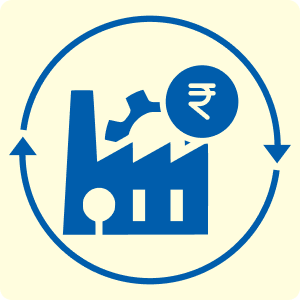You may be eligible for a pre-approved personal loan offer
Enter mobile and OTP | Check loan offer | Apply online
When borrowing through financial instruments like retail loans, understanding the factors that influence loan costs is essential. While interest rates, tenure, and fees are well-known, the reverse repo rate is often overlooked, though it plays a significant role in determining personal loan interest rates. Like the repo rate, the reverse repo rate is used by the Reserve Bank of India to inject liquidity and maintain economic stability. As of December 2025, the reverse repo rate stands at 3.35%. Staying informed about these rates is crucial for borrowers looking to manage and reduce interest costs effectively.
What is the reverse repo rate?
As far as the reverse repo rate meaning is concerned, it is contrary to the repo rate. The reverse repo rate is RBI’s interest rate for commercial banks. Here, banks deposit surplus funds with the RBI at a favourable rate and earn interest on it. The RBI injects liquidity into the economy and increases purchasing power when it lowers the reverse repo rate.
It is important to note that the key difference between repo and reverse repo rate is that the repo rate will always be higher in comparison. A higher reverse repo rate would encourage banks to store funds with the RBI rather than make them available for lending. The difference between the repo rate and the reverse repo rate is indicative of the RBI’s income.
What is repo rate?
The repo rate is the interest rate the Reserve Bank of India (RBI) charges commercial banks when they borrow money using government securities like treasury bills as collateral. ‘Repo’ stands for repurchasing agreement, which means the RBI lends money to banks with an agreement that they will buy back these securities at a set date and price. By changing the repo rate, the RBI can control the flow of money in the economy and manage inflation.
How does the repo rate work?
The repo rate is the interest rate at which the Reserve Bank of India (RBI) lends short-term funds to commercial banks against government securities. Here’s how it works:
- Borrowing process: When banks need short-term funds, they can borrow from the RBI at the repo rate. They pledge government bonds or securities as collateral.
- Interest payment: Banks pay interest on the borrowed funds at the repo rate.
- Monetary policy tool: The RBI adjusts the repo rate to control inflation and manage economic growth. A higher repo rate discourages borrowing and cools down inflation, while a lower rate encourages borrowing and stimulates economic activity.
Impact of reverse repo rate on economy
The reverse repo rate is a monetary policy tool used by the Reserve Bank of India (RBI) to control money supply and influence economic conditions. Here’s a detailed look at its impact on the economy:
1. Control of inflation
- Description: When the RBI increases the reverse repo rate, it offers banks a higher interest rate on the money they deposit with the RBI.
- Impact: This encourages banks to park more money with the RBI rather than lending it out, thereby reducing the amount of money circulating in the economy.
- Effect: Lower money supply helps to curb inflation, stabilizing prices for goods and services.
2. Influence on interest rates
- Description: The reverse repo rate acts as a floor for short-term interest rates in the money market.
- Impact: Higher reverse repo rates typically lead to increased short-term interest rates for loans and deposits.
- Effect: This can make borrowing more expensive for businesses and consumers, potentially slowing economic growth.
3. Bank liquidity management
- Description: The reverse repo rate is used to manage liquidity in the banking system.
- Impact: By adjusting this rate, the RBI can influence the amount of excess liquidity banks hold.
- Effect: Increased reverse repo rates can absorb excess liquidity, helping to maintain financial stability.
4. Encouragement for investment
- Description: Lower reverse repo rates encourage banks to lend more rather than depositing funds with the RBI.
- Impact: More available credit can stimulate investments by businesses and consumer spending.
- Effect: This can boost economic growth, job creation, and overall economic activity.
5. Exchange rate effects
- Description: Changes in the reverse repo rate can influence foreign investment flows.
- Impact: Higher rates may attract foreign investors looking for better returns, affecting the exchange rate.
- Effect: A stronger currency might result from increased foreign investment, impacting exports and imports.
Difference between repo rate and reverse repo rate
Here is a clear comparison between the repo rate and the reverse repo rate to help you understand how each impacts the economy.
-
Reverse repo rate Repo rate Banks deposit excess funds with the RBI and earn interest. Banks borrow funds from the RBI by pledging government securities as collateral. Increase in rate → Banks park more money with RBI → Lower liquidity in the economy. Increase in rate → Higher cost of funds → Loans become costlier. Decrease in rate → Banks deposit less with RBI → Higher liquidity. Decrease in rate → Lower cost of funds → Supports lending. RBI pays interest to banks under a reverse repurchase agreement. Banks pay interest to RBI under a repurchase agreement. Helps RBI absorb excess money supply and manage liquidity. Helps RBI control inflation and regulate credit flow.
Current repo rate in India
As of 2025, the reverse repo rate in India remains at 3.35%, which has been unchanged since May 2020. This rate is set by the Reserve Bank of India (RBI) and represents the interest earned by commercial banks when they deposit surplus short-term funds with the RBI against government securities.
Although the reverse repo rate continues to exist, the RBI has been using the Standing Deposit Facility (SDF) as the primary tool for absorbing liquidity. However, the reverse repo rate still forms part of the RBI’s broader monetary policy framework.
Key Points About the Reverse Repo Rate
- Current reverse repo rate: 3.35%
- Status in 2025: Unchanged since May 2020
- Set by: Reserve Bank of India (RBI)
- Purpose: To absorb excess liquidity and support monetary stability
- Impact: Influences short-term interest rates and overall liquidity conditions
For the latest updates, refer to the official RBI website.
*Terms and conditions apply
Key offerings: 3 loan types
Personal loan interest rate and applicable charges
Type of fee |
Applicable charges |
Rate of interest per annum |
10% to 31% p.a. |
Processing fees |
Up to 3.93% of the loan amount (inclusive of applicable taxes). |
Flexi Facility Charge |
Term Loan – Not applicable Flexi Loans –Up To Rs 1,999 To Up To Rs 18,999/- (Inclusive Of Applicable Taxes) |
Bounce charges |
Rs. 700 to Rs. 1,200/- per bounce “Bounce Charges” shall mean charges levied on each instance in the event of: (i) dishonour of any payment instrument irrespective of whether the customer subsequently makes the payment through an alternate mode or channel on the same day; and/or (ii) non-payment of instalment(s) on their respective due dates where any payment instrument is not registered/furnished; and/or (iii) rejection or failure of mandate registration by the customer’s bank. |
Part-prepayment charges |
Full Pre-payment: |
Penal charge |
Delay in payment of instalment(s) shall attract Penal Charge at the rate of up to 36% per annum per instalment from the respective due date until the date of receipt of the full instalment(s) amount. |
Stamp duty (as per respective state) |
Payable as per state laws and deducted upfront from loan amount. |
Annual maintenance charges |
Term Loan: Not applicable Flexi Term (Dropline) Loan: Up to 0.472% (Inclusive of applicable taxes) of the Dropline limit (as per the repayment schedule) on the date of levy of such charges.
Up to 0.472% (Inclusive Of Applicable Taxes) Of The Dropline Limit During Initial Tenure. Up to 0.472% (Inclusive Of Applicable Taxes) Of Dropline Limit During Subsequent Tenure |
Related Articles
Disclaimer
Bajaj Finance Limited has the sole and absolute discretion, without assigning any reason to accept or reject any application. Terms and conditions apply*.
For customer support, call Personal Loan IVR: 7757 000 000









 Personal Loan
Personal Loan Check Eligibility
Check Eligibility Salaried Personal Loan
Salaried Personal Loan EMI Calculator
EMI Calculator Account Aggregator
Account Aggregator Credit Pulse Report
Credit Pulse Report
 Deals starting @99
Deals starting @99 Min. 50% off
Min. 50% off
 Bajaj Pay
Bajaj Pay Wallet to Bank
Wallet to Bank
 Easy EMI Loan
Easy EMI Loan Savings Offer
Savings Offer Smartphones
Smartphones Led TVs
Led TVs Washing Machines
Washing Machines Laptops
Laptops Refrigerators
Refrigerators Air Conditioner
Air Conditioner Air Coolers
Air Coolers
 Loan Against Shares
Loan Against Shares Loan Against Mutual Funds
Loan Against Mutual Funds Loan Against Insurance Policy
Loan Against Insurance Policy ESOP Financing
ESOP Financing Easy EMI Loan
Easy EMI Loan Two-wheeler Loan
Two-wheeler Loan Loan for Lawyer
Loan for Lawyer Industrial Equipment Finance
Industrial Equipment Finance Industrial Equipment Balance Transfer
Industrial Equipment Balance Transfer Industrial Equipment Refinance
Industrial Equipment Refinance Personal Loan Branch Locator
Personal Loan Branch Locator Used Tractor Loan
Used Tractor Loan Loan Against Tractor
Loan Against Tractor Tractor Loan Balance Transfer
Tractor Loan Balance Transfer Flexi
Flexi View All
View All
 Two-wheeler Loan
Two-wheeler Loan Bike
Bike Scooter
Scooter Electric Vehicle
Electric Vehicle Best Sellers
Best Sellers Popular Brands
Popular Brands

 Trading Account
Trading Account Open Demat Account
Open Demat Account Margin Trading Financing
Margin Trading Financing Share Market
Share Market Invest in IPO
Invest in IPO All stocks
All stocks Top gainers
Top gainers Top losers
Top losers 52 week high
52 week high 52 week low
52 week low Loan against shares
Loan against shares
 Home Loan
Home Loan Transfer your existing Home loan
Transfer your existing Home loan Loan against Property
Loan against Property Home Loan for Salaried
Home Loan for Salaried Home loan for self employed
Home loan for self employed Loan Against Property Balance Transfer
Loan Against Property Balance Transfer Home Loan EMI Calculator
Home Loan EMI Calculator Home Loan eligibility calculator
Home Loan eligibility calculator Home Loan balance transfer
Home Loan balance transfer View All
View All
 Term Life Insurance
Term Life Insurance ULIP Plan
ULIP Plan Savings Plan
Savings Plan Family Insurance
Family Insurance Senior Citizen Health Insurance
Senior Citizen Health Insurance Critical Illness Insurance
Critical Illness Insurance Child Health Insurance
Child Health Insurance Pregnancy and Maternity Health Insurance
Pregnancy and Maternity Health Insurance Individual Health Insurance
Individual Health Insurance Low Income Health Insurance
Low Income Health Insurance Student Health Insurance
Student Health Insurance Group Health Insurance
Group Health Insurance Retirement Plans
Retirement Plans Child Plans
Child Plans Investment Plans
Investment Plans
 Business Loan
Business Loan Secured Business Loan
Secured Business Loan Loan against property
Loan against property Loans against property balance transfer
Loans against property balance transfer Loan against shares
Loan against shares Home Loan
Home Loan Loans against mutual funds
Loans against mutual funds Loan against bonds
Loan against bonds Loan against insurance policy
Loan against insurance policy
 Apply for Gold Loan
Apply for Gold Loan Transfer your Gold Loan with Us
Transfer your Gold Loan with Us Gold Loan Branch Locator
Gold Loan Branch Locator
 ULIP Plan
ULIP Plan Savings Plan
Savings Plan Retirement Plans
Retirement Plans Child Plans
Child Plans Free Demat Account
Free Demat Account Invest in Stocks
Invest in Stocks Invest in IPO
Invest in IPO Margin Trading Facility
Margin Trading Facility Fixed Deposit Branch Locator
Fixed Deposit Branch Locator
 Check your Credit Score
Check your Credit Score
 New Car Loan
New Car Loan Used Car Loan
Used Car Loan Loan Against Car
Loan Against Car Car Loan Balance Transfer and Top-up
Car Loan Balance Transfer and Top-up My Garage
My Garage
 Get Bajaj Prime
Get Bajaj Prime
 Mobiles on EMI
Mobiles on EMI Electronics on EMI Offer
Electronics on EMI Offer  Iphone on EMI
Iphone on EMI LED TV on EMI
LED TV on EMI Refrigerator on EMI
Refrigerator on EMI Laptop on EMI
Laptop on EMI Kitchen appliances on EMI
Kitchen appliances on EMI Washing machines
Washing machines
 Personal Loan EMI Calculator
Personal Loan EMI Calculator Personal Loan Eligibility Calculator
Personal Loan Eligibility Calculator Home Loan EMI Calculator
Home Loan EMI Calculator Home Loan Eligibility Calculator
Home Loan Eligibility Calculator Good & Service Tax (GST) Calculator
Good & Service Tax (GST) Calculator Flexi Day Wise Interest Calculator
Flexi Day Wise Interest Calculator Flexi Transaction Calculator
Flexi Transaction Calculator Secured Business Loan Eligibility Calculator
Secured Business Loan Eligibility Calculator Fixed Deposits Interest Calculator
Fixed Deposits Interest Calculator Two wheeler Loan EMI Calculator
Two wheeler Loan EMI Calculator New Car Loan EMI Calculator
New Car Loan EMI Calculator Used Car Loan EMI Calculator
Used Car Loan EMI Calculator All Calculator
All Calculator Used Tractor Loan EMI Calculator
Used Tractor Loan EMI Calculator
 Hot Deals
Hot Deals Clearance Sale
Clearance Sale Kitchen Appliances
Kitchen Appliances Tyres
Tyres Camera & Accessories
Camera & Accessories Mattresses
Mattresses Furniture
Furniture Watches
Watches Music & Audio
Music & Audio Cycles
Cycles Mixer & Grinder
Mixer & Grinder Luggage & Travel
Luggage & Travel Fitness Equipment
Fitness Equipment Fans
Fans
 Personal Loan for Doctors
Personal Loan for Doctors Business loan for Doctors
Business loan for Doctors Home Loan
Home Loan Secured Business Loan
Secured Business Loan Loan against property
Loan against property Secured Business Loan Balance Transfer
Secured Business Loan Balance Transfer Loan against share
Loan against share Gold Loan
Gold Loan Medical Equipment Finance
Medical Equipment Finance
 Smart Hub
Smart Hub ITR Service
ITR Service Digi Sarkar
Digi Sarkar
 Savings Offer
Savings Offer Easy EMI
Easy EMI Offer World
Offer World 1 EMI OFF
1 EMI OFF New Launches
New Launches Zero Down Payment
Zero Down Payment Clearance Sale
Clearance Sale Bajaj Mall Sale
Bajaj Mall Sale
 Mobiles under ₹20,000
Mobiles under ₹20,000 Mobiles under ₹25,000
Mobiles under ₹25,000 Mobiles under ₹30,000
Mobiles under ₹30,000 Mobiles under ₹35,000
Mobiles under ₹35,000 Mobiles under ₹40,000
Mobiles under ₹40,000 Mobiles under ₹50,000
Mobiles under ₹50,000
 Articles
Articles
 Overdue Payments
Overdue Payments Other Payments
Other Payments
 Document Center
Document Center Bank details & Documents
Bank details & Documents Tax Invoice Certificate
Tax Invoice Certificate
 Do Not Call Service
Do Not Call Service
 Hamara Mall Orders
Hamara Mall Orders

 Fixed Deposit (IFA) Partner
Fixed Deposit (IFA) Partner Loan (DSA) Partner
Loan (DSA) Partner Debt Management Partner
Debt Management Partner EMI Network Partner
EMI Network Partner Became a Merchant
Became a Merchant Partner Sign-in
Partner Sign-in
 Trade directly with your Demat A/c
Trade directly with your Demat A/c ITR
ITR My Garage
My Garage
 Live Videos - Beta
Live Videos - Beta
 Savings Offer
Savings Offer Smartphones
Smartphones LED TVs
LED TVs Washing Machines
Washing Machines Laptops
Laptops Refrigerators
Refrigerators Air Conditioners
Air Conditioners Air Coolers
Air Coolers Water Purifiers
Water Purifiers Tablets
Tablets Kitchen Appliances
Kitchen Appliances Mattresses
Mattresses Furniture
Furniture Music and Audio
Music and Audio Cameras & Accessories
Cameras & Accessories Cycle
Cycle Watches
Watches Tyres
Tyres Luggage & Travel
Luggage & Travel Fitness Equipment
Fitness Equipment Tractor
Tractor Easy EMI Loan
Easy EMI Loan
 vivo Mobiles
vivo Mobiles OPPO Mobiles
OPPO Mobiles Xiaomi Mobiles
Xiaomi Mobiles Sony LED TVs
Sony LED TVs Samsung LED TVs
Samsung LED TVs LG LED TVs
LG LED TVs Haier LED TVs
Haier LED TVs Godrej Refrigerators
Godrej Refrigerators Voltas Washing Machines
Voltas Washing Machines
 New Tractor Loan
New Tractor Loan Used Tractor Loan
Used Tractor Loan Loan Against Tractor
Loan Against Tractor Tractor Loan Balance Transfer
Tractor Loan Balance Transfer
 New Car Loan
New Car Loan New Cars Under ₹10 Lakh
New Cars Under ₹10 Lakh New Cars – ₹10–₹15 Lakh
New Cars – ₹10–₹15 Lakh New Cars – ₹15–₹20 Lakh
New Cars – ₹15–₹20 Lakh New Cars – ₹20–₹25 Lakh
New Cars – ₹20–₹25 Lakh New Car Brands
New Car Brands Petrol – New Cars
Petrol – New Cars Diesel – New Cars
Diesel – New Cars Electric – New Cars
Electric – New Cars CNG – New Cars
CNG – New Cars Hybrid – New Cars
Hybrid – New Cars











